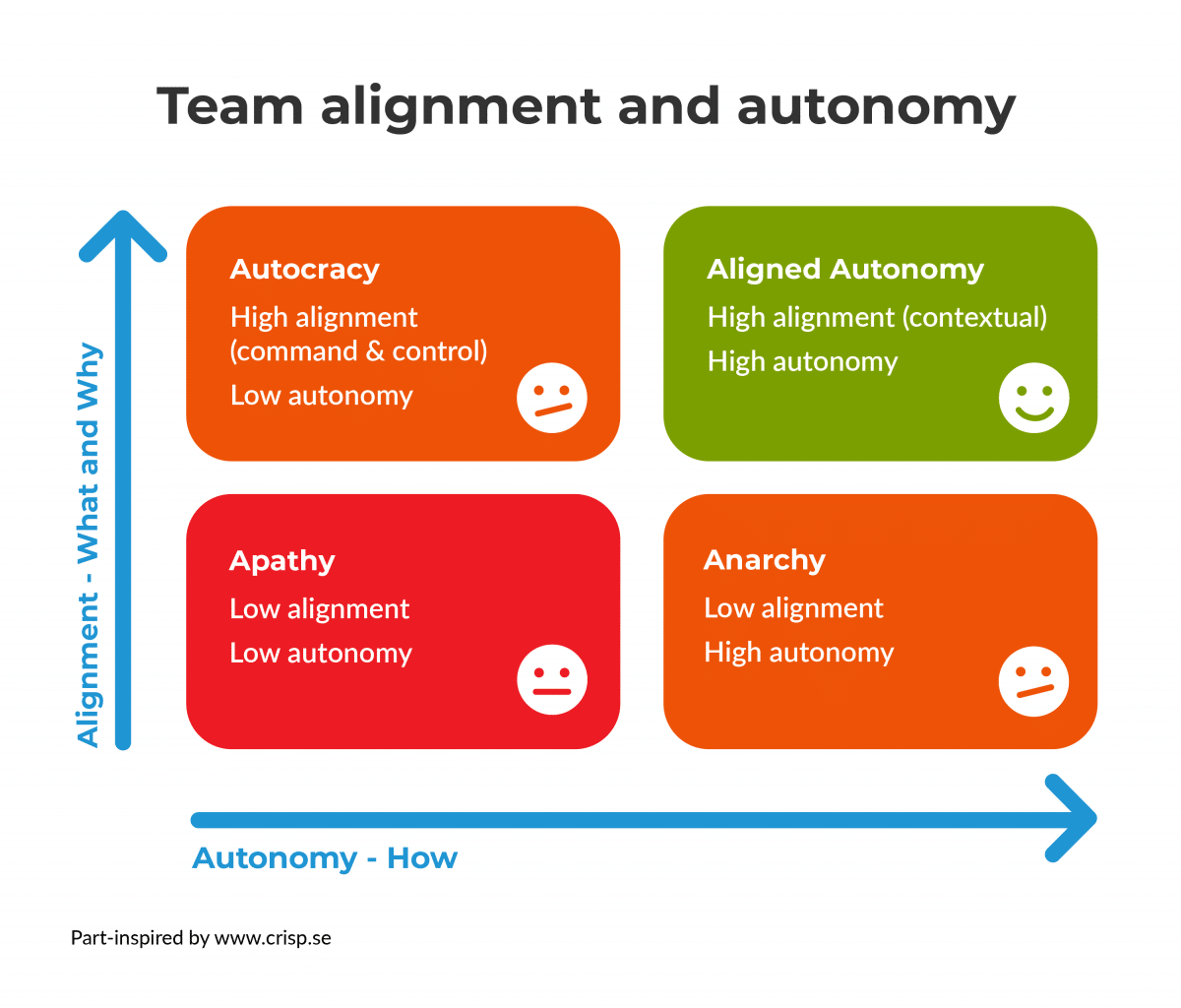Our Thinking Mon 26th September, 2022
Why you need alignment with autonomy at scale
I speak with customers and consultants across the Equal Experts network, to help our customers understand what’s needed to speed up innovation and reduce total cost of ownership at scale. That could include design systems, data workloads, or digital services.
We’ve helped a lot of organizations to scale up, including a government tax department with 80+ teams, and a high end retailer with 40+ teams. When I talk with people about how to succeed at scale, alignment with autonomy is a popular topic. In this series, I’ll look at the topic in-depth, including how to implement aligned autonomy in your own organization. If you’re in a rush, I’d just say:
To succeed at scale, give your teams contextual alignment with autonomy
Alignment is the what and why
Alignment means a shared direction. It’s the what and why – the glue between vision, strategy, and execution. Teams make better decisions when they understand the intent, purpose, and constraints behind their work.
Examples from the Equal Experts network of teams lacking alignment include:
- 3 teams at a telco unnecessarily building 3 different versions of 1 product capability
- 2 government agencies designing 1 shared service as 2 conflicting sets of APIs
- 10 teams at an insurer running 10 similar workloads on 10 different AWS runtimes
Autonomy is the how
Autonomy means an ability to make decisions. It’s the how – the capability and confidence to do something. Teams make decisions faster when they can do it without handoffs, and make better decisions when they can learn from their own mistakes.
Examples of teams lacking autonomy include:
- 8 teams at a media conglomerate waiting on 2 product managers to prioritize everything from 2 shared backlogs
- 10 teams at a payments provider waiting on 1 head of engineering to approve each technical specification upfront
- Forty teams at a government agency waiting on 3 solution architects to review each technology solution
Alignment and autonomy as opposites leads to failure
Your organization needs alignment and autonomy in product, culture, technology, ways of working, and more. However, it’s likely they’re treated as opposites, and you regularly have to choose between alignment and autonomy. This happens when your leadership implements alignment as command and control. As a result, when decisions have to be made teams will oppose increasing alignment for fear of less autonomy, and your leadership will oppose increasing autonomy for fear of less alignment.
Alignment without autonomy is autocracy. In the above media conglomerate example, the product director resisted team autonomy and insisted on 2 backlogs to protect command and control product alignment. The 8 teams were unable to work independently on product capabilities, and often had to wait for decisions to be made. Feature launches were only bi-monthly, and innovation was thought to be impossible.
Autonomy without alignment is anarchy. In the above AWS insurer example, the 10 tech leads resisted alignment on AWS runtimes, and insisted on the status quo to protect their autonomy. Those teams frequently had to upgrade, secure, deploy, monitor, and repair their 10 workloads in 10 different ways. Teams spent ~80% of their time on unplanned BAU work, AWS billing costs were higher than necessary, and there was little innovation.
Alignment and autonomy as opposites leads to failure. It doesn’t have to be this way.
Why you need alignment and autonomy to succeed at scale
Customers and consultants across the Equal Experts network agree that alignment and autonomy are key to success at scale. You can’t unlock speed, creativity, and innovation across 10, 30, or 50+ teams if they are unmotivated, and surrounded by dependencies. You have to increase alignment so teams understand the big picture, and increase autonomy so they can solve problems themselves with zero handoffs.
To succeed at scale, your organization has to implement alignment and autonomy together. This means replacing command and control with contextual alignment, and giving teams the freedom to to make decisions in that context. This is known as aligned autonomy, from Henrik Kniberg’s work on Spotify culture and Stephen Bungay’s The Art of Action. 
Implementing aligned autonomy starts with your leadership creating the right conditions. This includes outlining an organizational vision, communicating a product-technology context of desired customer impacts and technology direction, and creating a high trust culture in which outcome-oriented teams can make decisions for themselves. Those conditions then need to be protected by your teams using process and technology changes, such as automated metrics for customer impacts and paved roads for engineer enablement.
Independent, empowered product teams can achieve spectacular results. Later in this series, I’ll share how we help our customers to implement alignment with autonomy, look at the trade-offs in the Spotify Model and SAFe, and ask some Equal Experts consultants to contribute their own experiences. For now, I’ll just say:
To succeed at scale, give your teams contextual alignment with autonomy



